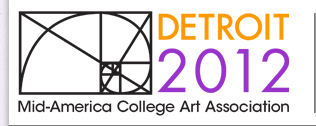Session Title
Between the Literary and the Visual: Inter-Artistic Approaches to African-American Art History
Start Date
4-10-2012 1:15 PM
End Date
4-10-2012 2:45 PM
Session Description
A stubborn truism vexes African-American art history: the canon of black American literature is viewed as more established and robust than that of black American visual arts. This misconception has more to do with conventional disciplinary divisions, than it does with either the quantity or quality of black visual expression. Segregating the "literary" from the "visual"--and assigning these to English and Art History departments, respectively--has obscured the originally inter-artistic nature of much black cultural expression as well as the terms of its early reception and critique.
African-American artists have repeatedly worked in black literary contexts--from Aaron Douglas's illustrations for Alain Locke's The New Negro to Glenn Ligon's painted excerpts from Ralph Ellison and Richard Pryor. At the same time, many (nonblack) literary critics have been enthusiastic interpreters of black visual arts. Theater critic and novelist Carl Van Vechten promoted the painters of the Harlem Renaissance; Sidney Hirsch, one of Vanderbilt University's influential literary modernists, "discovered" black folk sculptor William Edmondson; and French poststructuralist Roland Barthes famously used a photograph by James Van Der Zee to explain his concept of the photographic punctum.
This panel seeks papers that take stock of this prodigious overlap between the literary and the visual arts. Participants are invited to address how literature and literary criticism may productively inform African-American art history, to recount the specific historical circumstances that compel this approach, and to consider broadly how attention to inter-artistic histories might helpfully reform both approaches to and canons of black cultural expression.
Between the Literary and the Visual: Inter-Artistic Approaches to African-American Art History
A stubborn truism vexes African-American art history: the canon of black American literature is viewed as more established and robust than that of black American visual arts. This misconception has more to do with conventional disciplinary divisions, than it does with either the quantity or quality of black visual expression. Segregating the "literary" from the "visual"--and assigning these to English and Art History departments, respectively--has obscured the originally inter-artistic nature of much black cultural expression as well as the terms of its early reception and critique.
African-American artists have repeatedly worked in black literary contexts--from Aaron Douglas's illustrations for Alain Locke's The New Negro to Glenn Ligon's painted excerpts from Ralph Ellison and Richard Pryor. At the same time, many (nonblack) literary critics have been enthusiastic interpreters of black visual arts. Theater critic and novelist Carl Van Vechten promoted the painters of the Harlem Renaissance; Sidney Hirsch, one of Vanderbilt University's influential literary modernists, "discovered" black folk sculptor William Edmondson; and French poststructuralist Roland Barthes famously used a photograph by James Van Der Zee to explain his concept of the photographic punctum.
This panel seeks papers that take stock of this prodigious overlap between the literary and the visual arts. Participants are invited to address how literature and literary criticism may productively inform African-American art history, to recount the specific historical circumstances that compel this approach, and to consider broadly how attention to inter-artistic histories might helpfully reform both approaches to and canons of black cultural expression.

